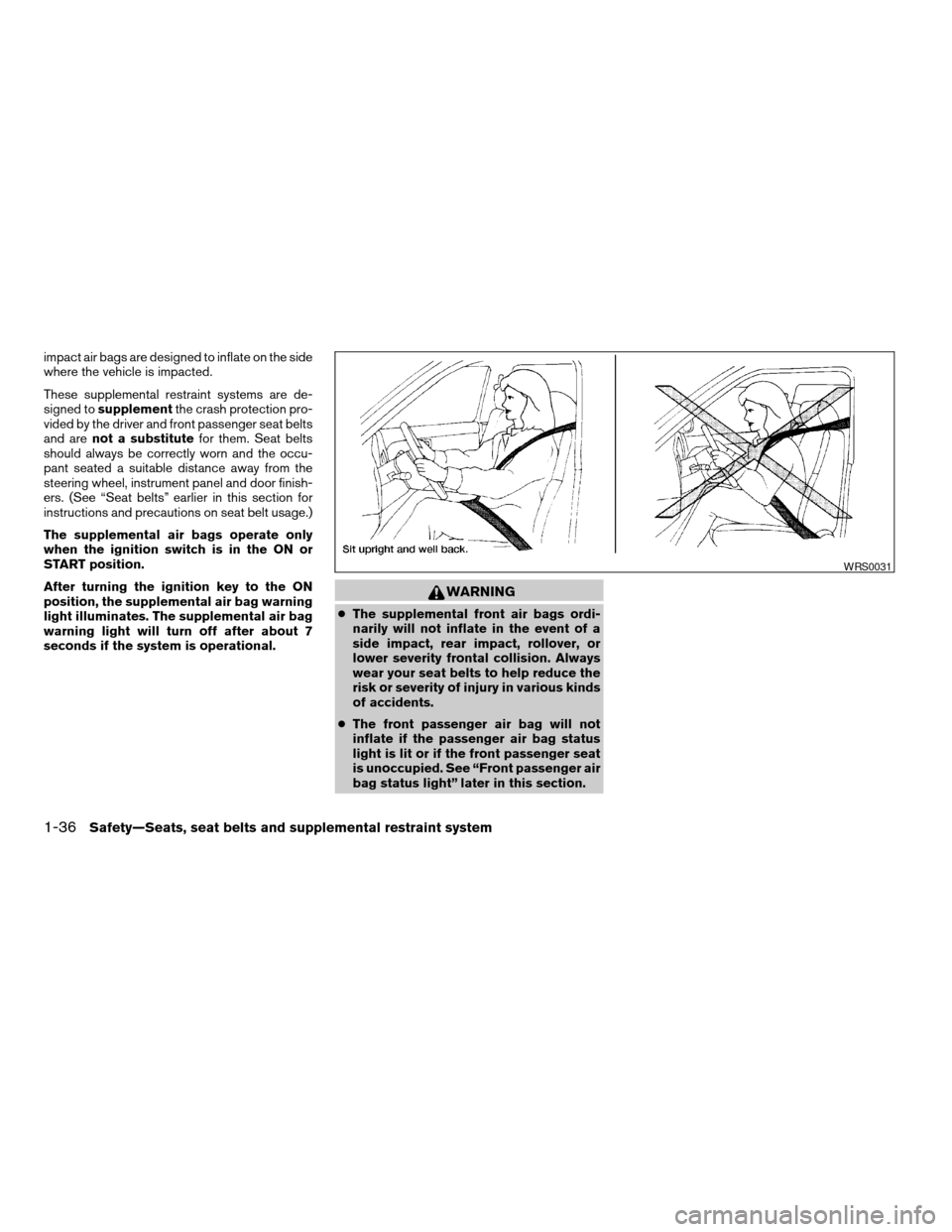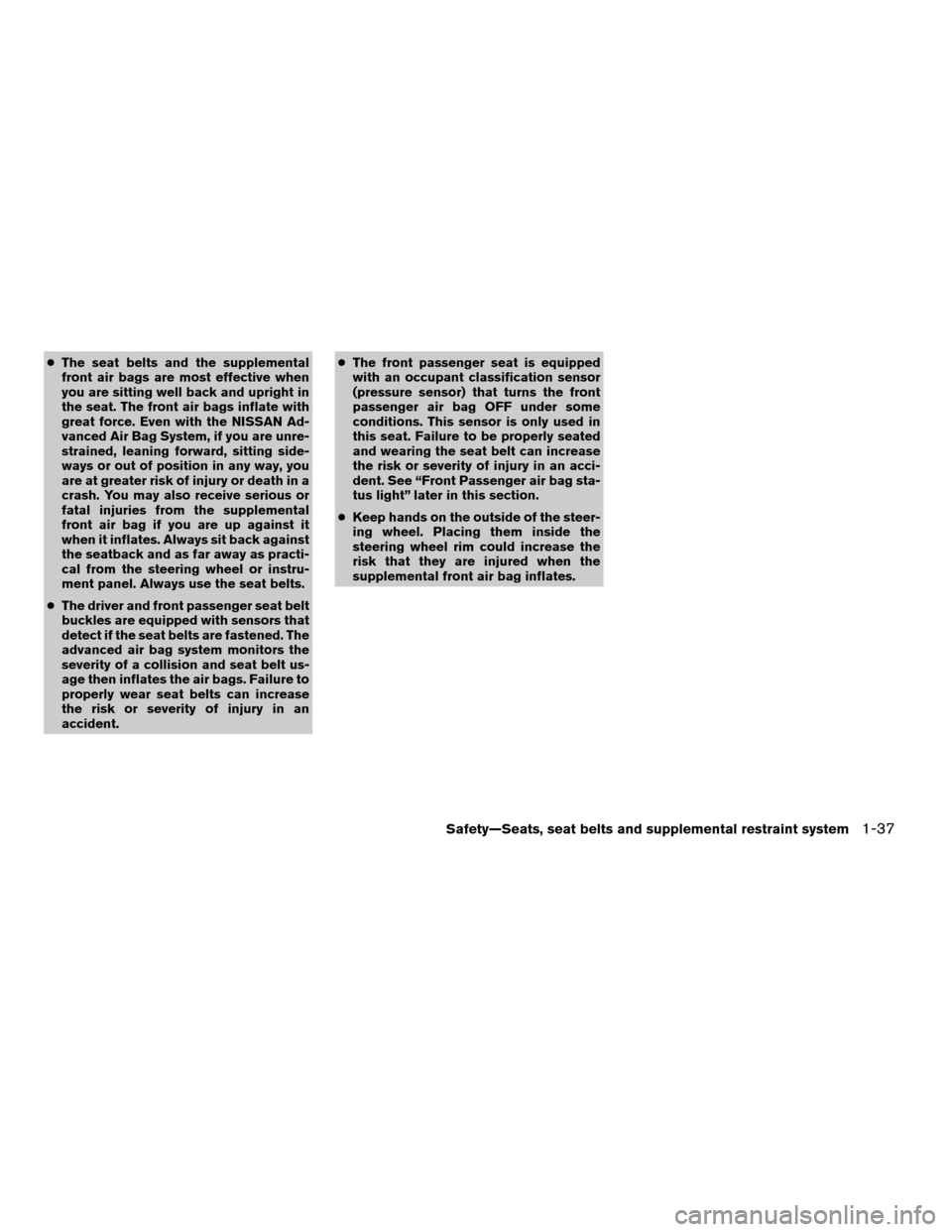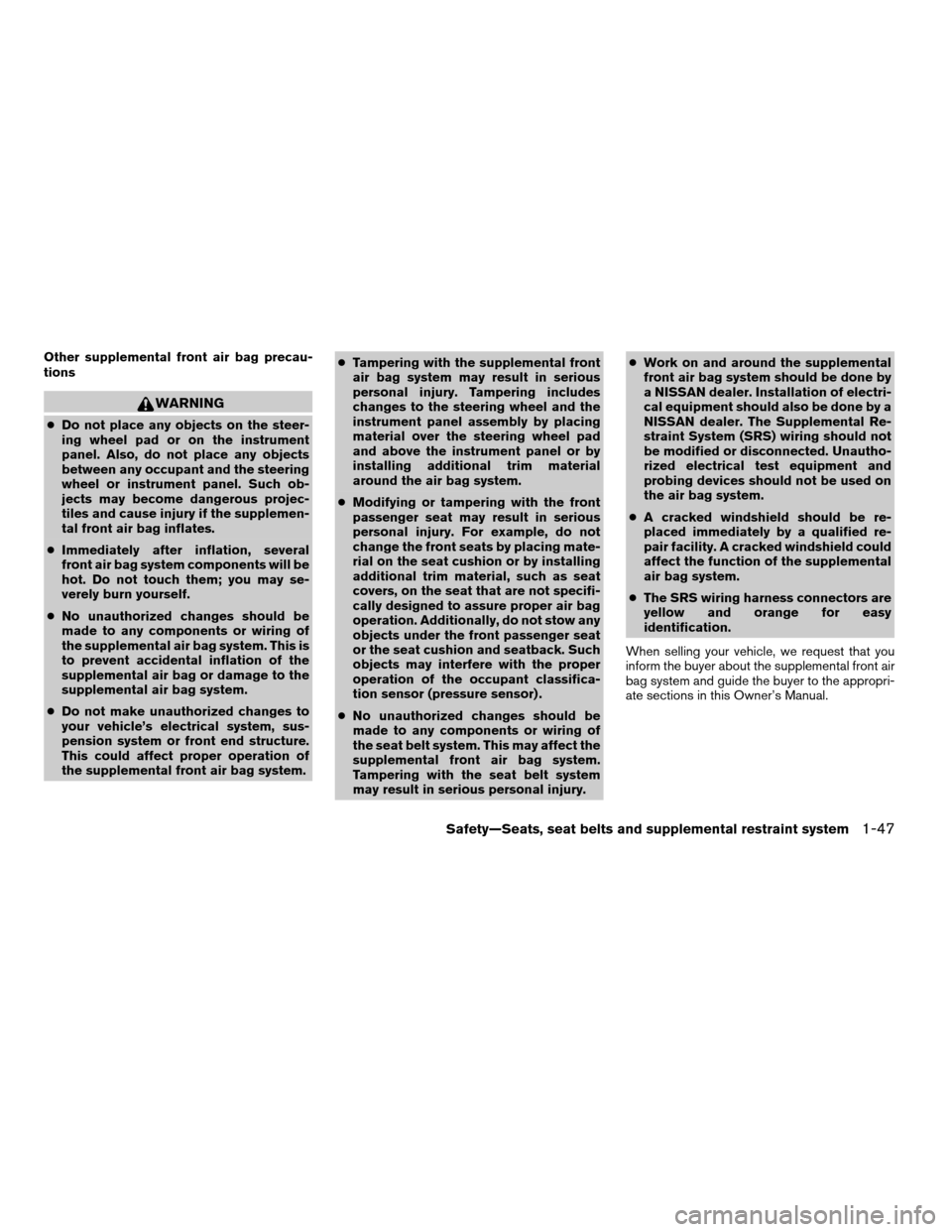2008 NISSAN MAXIMA wheel
[x] Cancel search: wheelPage 12 of 328

1. Side and center ventilators (P. 4-18)
2. Headlight/fog light/turn signal switch
(P. 2-22)
3. Steering wheel switch for audio control
and BluetoothTHands-Free Phone
System (if so equipped) (P. 4-44, 4-46)4. Meters and gauges (P. 2-3)
5. Driver supplemental air bag/horn
(P. 1-35, P. 2-28)
6. Security indicator light (P. 2-17)
7. Cruise control main/set switches
(P. 5-14)8. Windshield wiper/washer switch
(P. 2-20)
9. Display screen/Navigation system*
(P. 4-2, P. 4-6)
10. Display screen/Navigation system*
controls (P. 4-2, P. 4-6)
11. Front passenger supplemental air bag
(P. 1-35)
12. Glove box (P. 2-34)
13. Audio system controls (P. 4-22)
14. Climate controls (P. 4-19)
15. Storage (P. 2-32)
16. Power outlet (P. 2-31)
17. Shift selector lever (P. 5-9)
18. Hazard warning flasher switch (P. 2-27)
19. Passenger air bag status light (P. 1-45)
20. Ignition switch (P. 5-6)
21. Tilt/telescopic steering wheel controls
(P. 3-22)
22. Traction Control System (TCS) off
switch (if so equipped) (P. 2-29) or
Vehicle Dynamic Control (VDC) off
switch (if so equipped) (P. 2-30)
23. Rear sonar system off switch
(if so equipped) (P. 2-30)
24. Outside mirror controls (P. 3-25)
25. Instrument brightness control (P. 2-26)
LIC0988
INSTRUMENT PANEL
0-6Illustrated table of contents
ZREVIEW COPYÐ2008 Maxima(max)
Owners ManualÐUSA_English(nna)
06/08/07Ðdebbie
X
Page 52 of 328

impact air bags are designed to inflate on the side
where the vehicle is impacted.
These supplemental restraint systems are de-
signed tosupplementthe crash protection pro-
vided by the driver and front passenger seat belts
and arenot a substitutefor them. Seat belts
should always be correctly worn and the occu-
pant seated a suitable distance away from the
steering wheel, instrument panel and door finish-
ers. (See “Seat belts” earlier in this section for
instructions and precautions on seat belt usage.)
The supplemental air bags operate only
when the ignition switch is in the ON or
START position.
After turning the ignition key to the ON
position, the supplemental air bag warning
light illuminates. The supplemental air bag
warning light will turn off after about 7
seconds if the system is operational.
WARNING
cThe supplemental front air bags ordi-
narily will not inflate in the event of a
side impact, rear impact, rollover, or
lower severity frontal collision. Always
wear your seat belts to help reduce the
risk or severity of injury in various kinds
of accidents.
cThe front passenger air bag will not
inflate if the passenger air bag status
light is lit or if the front passenger seat
is unoccupied. See “Front passenger air
bag status light” later in this section.
WRS0031
1-36Safety—Seats, seat belts and supplemental restraint system
ZREVIEW COPYÐ2008 Maxima(max)
Owners ManualÐUSA_English(nna)
06/08/07Ðdebbie
X
Page 53 of 328

cThe seat belts and the supplemental
front air bags are most effective when
you are sitting well back and upright in
the seat. The front air bags inflate with
great force. Even with the NISSAN Ad-
vanced Air Bag System, if you are unre-
strained, leaning forward, sitting side-
ways or out of position in any way, you
are at greater risk of injury or death in a
crash. You may also receive serious or
fatal injuries from the supplemental
front air bag if you are up against it
when it inflates. Always sit back against
the seatback and as far away as practi-
cal from the steering wheel or instru-
ment panel. Always use the seat belts.
cThe driver and front passenger seat belt
buckles are equipped with sensors that
detect if the seat belts are fastened. The
advanced air bag system monitors the
severity of a collision and seat belt us-
age then inflates the air bags. Failure to
properly wear seat belts can increase
the risk or severity of injury in an
accident.cThe front passenger seat is equipped
with an occupant classification sensor
(pressure sensor) that turns the front
passenger air bag OFF under some
conditions. This sensor is only used in
this seat. Failure to be properly seated
and wearing the seat belt can increase
the risk or severity of injury in an acci-
dent. See “Front Passenger air bag sta-
tus light” later in this section.
cKeep hands on the outside of the steer-
ing wheel. Placing them inside the
steering wheel rim could increase the
risk that they are injured when the
supplemental front air bag inflates.
Safety—Seats, seat belts and supplemental restraint system1-37
ZREVIEW COPYÐ2008 Maxima(max)
Owners ManualÐUSA_English(nna)
06/08/07Ðdebbie
X
Page 59 of 328

1. Roof-mounted curtain side-impact
supplemental air bag inflators
2. Roof-mounted curtain side-impact
supplemental air bags
3. Front seat-mounted side-impact
supplemental air bag modules4. Air bag Control Unit (ACU)
5. Supplemental front air bag modules
6. Crash zone sensor
7. Occupant classification system control
unit8. Seat belt buckle switches for driver’s
and passenger’s side
9. Occupant classification sensor (pres-
sure sensor)
10. Seat belt pretensioner
11. Side satellite sensor
NISSAN Advanced Air Bag System
(front seats)
This vehicle is equipped with the NISSAN Ad-
vanced Air Bag System for the driver and front
passenger seats. This system is designed to
meet certification requirements under U.S. regu-
lations. It is also permitted in Canada.However,
all of the information, cautions and warn-
ings in this manual still apply and must be
followed.
The driver supplemental front air bag is located in
the center of the steering wheel. The passenger
supplemental front air bag is mounted in the
dashboard above the glove box. The supplemen-
tal front air bags are designed to inflate in higher
severity frontal collisions, although they may in-
flate if the forces in another type of collision are
similar to those of a higher severity frontal impact.
They may not inflate in certain frontal collisions.
Vehicle damage (or lack of it) is not always an
indication of proper supplemental front air bag
system operation.
WRS0466
Safety—Seats, seat belts and supplemental restraint system1-43
ZREVIEW COPYÐ2008 Maxima(max)
Owners ManualÐUSA_English(nna)
06/08/07Ðdebbie
X
Page 60 of 328

The NISSAN Advanced Air Bag System has dual
stage inflators. It also monitors information from
the crash zone sensor, the Air Bag Control Unit
(ACU) , seat belt buckle sensors, occupant clas-
sification sensor (pressure sensor) and passen-
ger seat belt tension sensor. Inflator operation is
based on the severity of a collision and seat belt
usage for the driver. For the front passenger, it
additionally monitors the weight of an occupant
or object on the seat and seat belt tension. Based
on information from the sensors, only one front air
bag may inflate in a crash, depending on the
crash severity and whether the front occupants
are belted or unbelted. Additionally, the front
passenger air bag may be automatically turned
OFF under some conditions, depending on the
weight detected on the passenger seat and how
the seat belt is used. If the front passenger air bag
is OFF, the passenger air bag status light will be
illuminated (if the seat is unoccupied, the light will
not be illuminated, but the air bag will be off) . See
“Front passenger air bag and status light” later in
this section for further details. One front air bag
inflating does not indicate improper performance
of the system.
If you have any questions about your air bag
system, please contact NISSAN or your NISSAN
dealer. If you are considering modification of your
vehicle due to a disability, you may also contactNISSAN. Contact information is contained in the
front of this Owner’s Manual.
When a supplemental front air bag inflates, a
fairly loud noise may be heard, followed by the
release of smoke. This smoke is not harmful and
does not indicate a fire. Care should be taken to
not inhale it, as it may cause irritation and chok-
ing. Those with a history of a breathing condition
should get fresh air promptly.
Supplemental front air bags, along with the use of
seat belts, help to cushion the impact force on
the face and chest of the front occupants. They
can help save lives and reduce serious injuries.
However, an inflating front air bag may cause
facial abrasions or other injuries. Front air bags
do not provide restraint to the lower body.
Even with NISSAN advanced air bags, seat belts
should be correctly worn and the driver and pas-
senger seated upright as far as practical away
from the steering wheel or instrument panel. The
supplemental front air bags inflate quickly in order
to help protect the front occupants. Because of
this, the force of the front air bag inflating can
increase the risk of injury if the occupant is too
close to, or is against, the front air bag module
during inflation.
The front air bags deflate quickly after a collision.The supplemental front air bags operate
only when the ignition switch is in the ON
or START position.
After turning the ignition key to the ON
position, the supplemental air bag warning
light illuminates. The supplemental air bag
warning light will turn off after about 7
seconds if the system is operational.
1-44Safety—Seats, seat belts and supplemental restraint system
ZREVIEW COPYÐ2008 Maxima(max)
Owners ManualÐUSA_English(nna)
06/08/07Ðdebbie
X
Page 63 of 328

Other supplemental front air bag precau-
tions
WARNING
cDo not place any objects on the steer-
ing wheel pad or on the instrument
panel. Also, do not place any objects
between any occupant and the steering
wheel or instrument panel. Such ob-
jects may become dangerous projec-
tiles and cause injury if the supplemen-
tal front air bag inflates.
cImmediately after inflation, several
front air bag system components will be
hot. Do not touch them; you may se-
verely burn yourself.
cNo unauthorized changes should be
made to any components or wiring of
the supplemental air bag system. This is
to prevent accidental inflation of the
supplemental air bag or damage to the
supplemental air bag system.
cDo not make unauthorized changes to
your vehicle’s electrical system, sus-
pension system or front end structure.
This could affect proper operation of
the supplemental front air bag system.cTampering with the supplemental front
air bag system may result in serious
personal injury. Tampering includes
changes to the steering wheel and the
instrument panel assembly by placing
material over the steering wheel pad
and above the instrument panel or by
installing additional trim material
around the air bag system.
cModifying or tampering with the front
passenger seat may result in serious
personal injury. For example, do not
change the front seats by placing mate-
rial on the seat cushion or by installing
additional trim material, such as seat
covers, on the seat that are not specifi-
cally designed to assure proper air bag
operation. Additionally, do not stow any
objects under the front passenger seat
or the seat cushion and seatback. Such
objects may interfere with the proper
operation of the occupant classifica-
tion sensor (pressure sensor) .
cNo unauthorized changes should be
made to any components or wiring of
the seat belt system. This may affect the
supplemental front air bag system.
Tampering with the seat belt system
may result in serious personal injury.cWork on and around the supplemental
front air bag system should be done by
a NISSAN dealer. Installation of electri-
cal equipment should also be done by a
NISSAN dealer. The Supplemental Re-
straint System (SRS) wiring should not
be modified or disconnected. Unautho-
rized electrical test equipment and
probing devices should not be used on
the air bag system.
cA cracked windshield should be re-
placed immediately by a qualified re-
pair facility. A cracked windshield could
affect the function of the supplemental
air bag system.
cThe SRS wiring harness connectors are
yellow and orange for easy
identification.
When selling your vehicle, we request that you
inform the buyer about the supplemental front air
bag system and guide the buyer to the appropri-
ate sections in this Owner’s Manual.
Safety—Seats, seat belts and supplemental restraint system1-47
ZREVIEW COPYÐ2008 Maxima(max)
Owners ManualÐUSA_English(nna)
06/08/07Ðdebbie
X
Page 70 of 328

2 Instruments and controls
Instrument panel...................................2-2
Meters and gauges................................2-3
Speedometer and odometer.....................2-4
Tachometer....................................2-5
Engine coolant temperature gauge...............2-5
Fuel gauge....................................2-6
Compass display (if so equipped)...................2-6
Zone variation change procedure.................2-8
Warning/indicator lights and audible reminders......2-10
Checking bulbs...............................2-10
Warning lights................................2-11
Indicator lights................................2-14
Audible reminders.............................2-17
Security systems.................................2-17
Vehicle security system.........................2-17
NISSAN vehicle immobilizer system.............2-19
Windshield wiper and washer switch...............2-20
Switch operation..............................2-20
Rear window and outside mirror (if so equipped)
defroster switch..................................2-21
Headlight and turn signal switch....................2-22
Xenon headlights (if so equipped)...............2-22
Headlight control switch........................2-23Daytime running light system (Canada only)......2-25
Instrument brightness control...................2-26
Turn signal switch.............................2-26
Fog light switch...............................2-26
Cornering light................................2-27
Hazard warning flasher switch.....................2-27
Horn............................................2-28
Heated seats (if so equipped)......................2-28
Heated steering wheel (if so equipped).............2-29
Traction Control System (TCS) off switch
(if so equipped)..................................2-29
Vehicle Dynamic Control (VDC) off switch
(if so equipped)..................................2-30
Rear sonar system off switch (if so equipped)........2-30
Power outlet.....................................2-31
Storage.........................................2-32
Map pockets..................................2-32
Seatback pockets.............................2-32
Sunglasses holder.............................2-32
Cup holders..................................2-33
Glove box....................................2-34
Console box..................................2-34
Covered storage box...........................2-35
ZREVIEW COPYÐ2008 Maxima(max)
Owners ManualÐUSA_English(nna)
06/08/07Ðdebbie
X
Page 72 of 328

1. Side and center ventilators (P. 4-18)
2. Headlight/fog light/turn signal switch
(P. 2-22)
3. Steering wheel switch for audio control
and BluetoothTHands-Free Phone
System (if so equipped) (P. 4-44, 4-46)4. Meters and gauges (P. 2-3)
5. Driver supplemental air bag/horn
(P. 1-35, P. 2-28)
6. Security indicator light (P. 2-17)
7. Cruise control main/set switches
(P. 5-14)8. Windshield wiper/washer switch
(P. 2-20)
9. Display screen/Navigation system*
(P. 4-2, P. 4-6)
10. Display screen/Navigation system*
controls (P. 4-2, P. 4-6)
11. Front passenger supplemental air bag
(P. 1-35)
12. Glove box (P. 2-34)
13. Audio system controls (P. 4-22)
14. Climate controls (P. 4-19)
15. Storage (P. 2-32)
16. Power outlet (P. 2-31)
17. Shift selector lever (P. 5-9)
18. Hazard warning flasher switch (P. 2-27)
19. Passenger air bag status light (P. 1-45)
20. Ignition switch (P. 5-6)
21. Tilt/telescopic steering wheel controls
(P. 3-22)
22. Traction Control System (TCS) off
switch (if so equipped) (P. 2-29) or
Vehicle Dynamic Control (VDC) off
switch (if so equipped) (P. 2-30)
23. Rear sonar system off switch (if so
equipped) (P. 2-30)
24. Outside mirror controls (P. 3-25)
25. Instrument brightness control (P. 2-26)
LIC0988
INSTRUMENT PANEL
2-2Instruments and controls
ZREVIEW COPYÐ2008 Maxima(max)
Owners ManualÐUSA_English(nna)
06/08/07Ðdebbie
X